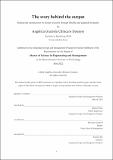The story behind the output: Enhancing transparency in design research through flexible and adapted strategies
Author(s)
Chíncaro Donayre, Angélica Graciela
DownloadThesis PDF (16.95Mb)
Advisor
Pontis, Sheila
Terms of use
Metadata
Show full item recordAbstract
Transparency is an integral element in achieving trustworthiness in qualitative research. Current transparency standards are generally built for academic contexts. They often require a substantial investment of time in explaining the rationale behind every step of the research process, synthesis being recognized as the most complex stage to follow, document, and communicate.
Design consultancies deal with different constraints from those faced by academic researchers, including tight deadlines, and clients’ participation, creating potential barriers to adopting the same kind of transparency strategies in the consultancy context. With this in mind, the exploration began by questioning: are transparency strategies currently being applied in the design consultancy world? If so, how? If not, why not? and how could design researchers be helped to do so?
The thesis used semi-structured online interviews with design research professionals to determine a broad set of themes relevant to the research questions. The subsequent identification of challenges and opportunities to apply transparency in online research led to (1) a new definition of transparency adapted to the design consultancy context, (2) a set of motivations to be intentionally transparent, and (3) a toolbox with strategies to integrate and improve transparency in different remote project situations a design researcher may face. This toolbox is meant to be collaborative, flexible, and fun while providing a stepping stone to purposefully start, encourage, and continue the transparency conversation.
Date issued
2022-05Department
System Design and Management Program.Publisher
Massachusetts Institute of Technology